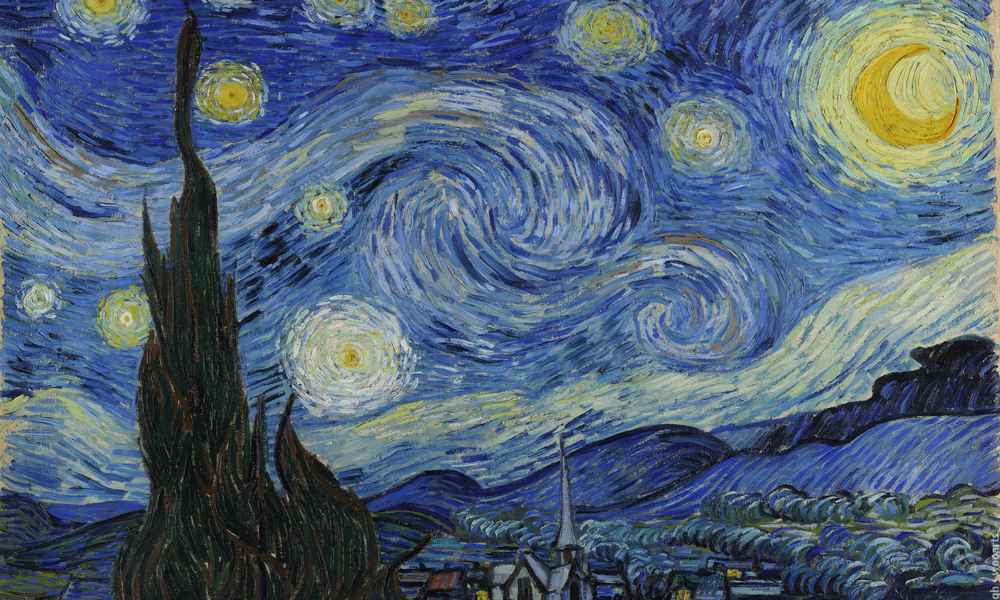Van Gogh’s Celestial Symphony: The Mesmerizing Starry Night

“The Starry Night” by Vincent van Gogh: A Deep Critical Analysis
Vincent van Gogh‘s “The Starry Night” is an iconic masterpiece that transcends its status as a mere painting, inviting viewers into a realm of profound emotion and artistic brilliance. Created in 1889 during Van Gogh’s stay at the Saint-Paul-de-Mausole asylum in Saint-Rémy-de-Provence, France, the painting has become synonymous with the artist’s unique vision and expressive style.
- Visual Impact: “The Starry Night” is an arresting composition that immediately captures the viewer’s attention. The bold, swirling patterns in the sky create a sense of movement and dynamism, drawing the eye towards the heavens. The village below, bathed in an otherworldly glow, grounds the painting and establishes a harmonious balance.
- Expressive Brushwork: Van Gogh’s distinctive and emotive brushwork is a defining feature of “The Starry Night.” The vigorous, swirling strokes convey a sense of energy and turbulence. The sky, in particular, appears to pulsate with life, as if Van Gogh sought to encapsulate the very essence of the celestial bodies.
- Color Palette: The color palette is both intense and evocative. Van Gogh’s use of vibrant blues, deep yellows, and rich greens contributes to the dreamlike quality of the scene. The contrast between the cool and warm tones enhances the emotional impact, creating a visual symphony that resonates with the viewer.
- Symbolism of the Cypress Tree: The prominent cypress tree in the foreground serves as a powerful symbol. Often associated with mourning and eternity, the cypress stands tall and dark against the celestial expanse. Its upward reach seems to echo the yearning of Van Gogh’s soul, emphasizing the spiritual and existential dimensions of the painting.
- Starry Night Sky: The night sky, ablaze with stars, is a celestial tapestry that conveys a sense of cosmic wonder. Van Gogh’s representation of the stars is both poetic and symbolic, suggesting a connection between the earthly and the divine. The swirling patterns evoke a sense of the infinite, transcending the mundane and tapping into the sublime.
- Emotional Resonance: “The Starry Night” is infused with a profound emotional resonance. Van Gogh’s use of color, form, and movement is not merely a representation of a night sky; it is an expression of the artist’s inner turmoil and contemplation. The painting serves as a visual diary of Van Gogh’s emotional state during a tumultuous period in his life.
- Influence of Impressionism and Post-Impressionism: While Van Gogh’s work is often associated with Post-Impressionism, “The Starry Night” also exhibits elements of Impressionism. The play of light, the emphasis on mood over realism, and the subjective interpretation of the scene align with both movements, showcasing Van Gogh’s ability to bridge artistic styles.
- Cultural Impact: “The Starry Night” has transcended its status as a painting to become a cultural touchstone. It has inspired countless artists, writers, and thinkers, cementing its place as an enduring symbol of artistic genius. The painting’s influence extends far beyond the art world, making it one of the most recognized and revered works in art history.
In conclusion, “The Starry Night” is a testament to Vincent van Gogh’s mastery as an artist and his ability to translate profound emotions into visual poetry. The painting’s enduring allure lies in its capacity to evoke a visceral response from viewers, inviting them to contemplate the mysteries of the cosmos and the depths of the human soul.
—
Van Gogh’s night sky is a field of roiling energy. Below the exploding stars, the village is a place of quiet order. Connecting earth and sky is the flamelike cypress, a tree traditionally associated with graveyards and mourning. But death was not ominous for van Gogh. “Looking at the stars always makes me dream,” he said, “Why, I ask myself, shouldn’t the shining dots of the sky be as accessible as the black dots on the map of France? Just as we take the train to get to Tarascon or Rouen, we take death to reach a star.”
The artist wrote of his experience to his brother Theo: “This morning I saw the country from my window a long time before sunrise, with nothing but the morning star, which looked very big.” This morning star, or Venus, may be the large white star just left of center in The Starry Night. The hamlet, on the other hand, is invented, and the church spire evokes van Gogh’s native land, the Netherlands. The painting, like its daytime companion, The Olive Trees, is rooted in imagination and memory. Leaving behind the Impressionist doctrine of truth to nature in favor of restless feeling and intense color, as in this highly charged picture, van Gogh made his work a touchstone for all subsequent Expressionist painting.
The Museum of Modern Art, MoMA Highlights, New York: The Museum of Modern Art, revised 2004, originally published 1999, p. 35
Find out more about The Starry Night at: mo.ma/starrynight
Details
Title: The Starry Night
Creator: Vincent van Gogh
Date Created: 1889
Location Created: Saint-Rémy-de-Provence
Style: Post-Impressionism
Provenance: Acquired through the Lillie P.Bliss Bequest
Physical Dimensions: w921 x h737 mm
Original Title: La nuit étoilée
More Info: View more works by Vincent van Gogh on MoMA.org
Type: Painting
External Link: View MoMA’s collection online
Medium: Oil on canvas